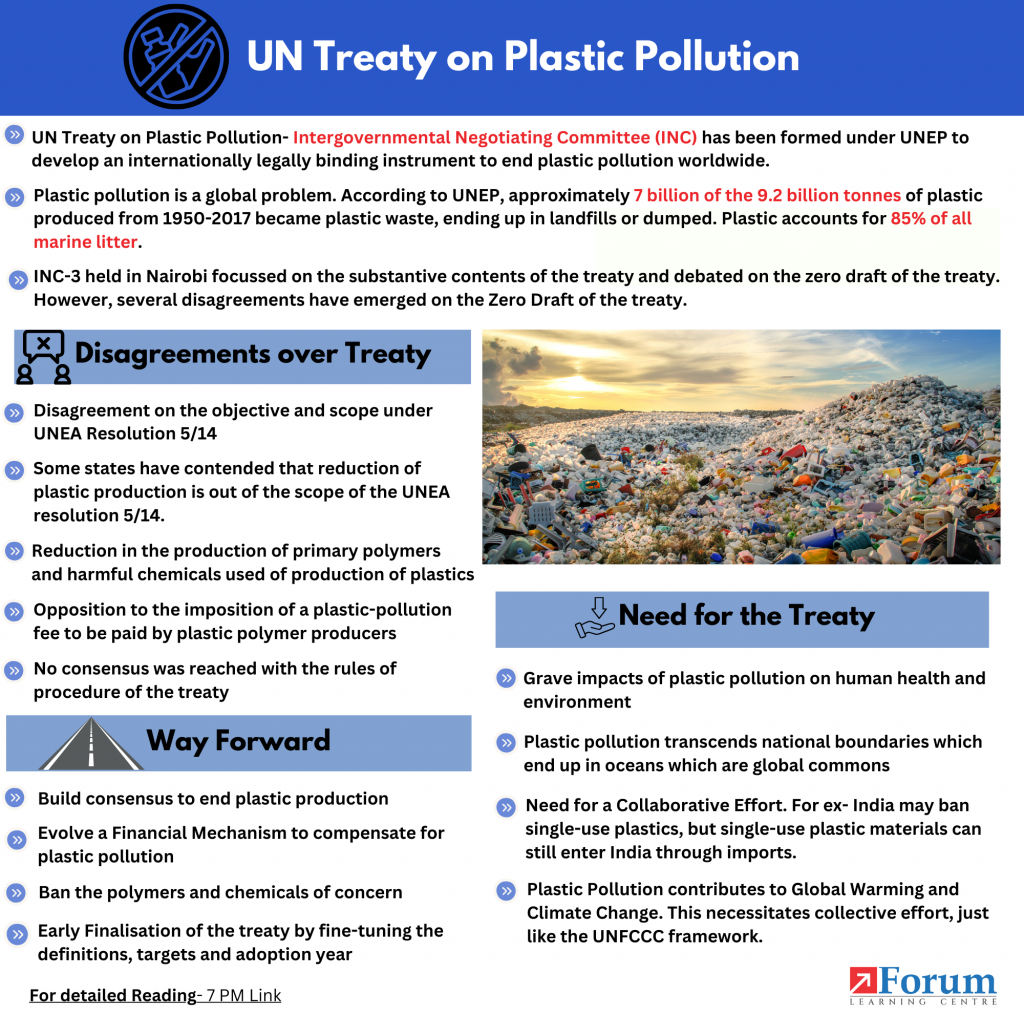ForumIAS announcing GS Foundation Program for UPSC CSE 2025-26 from 19 April. Click Here for more information.
The Intergovernmental Negotiating Committee (INC) has been formed under the United Nations Environment Programme (UNEP) to develop an internationally legally binding instrument to end plastic pollution worldwide. Under the UN Environment Assembly Resolution 5/14, the INC is responsible for delivering a global plastics treaty by 2025. The INC met in Nairobi from November 13 to 19 for its third round of negotiations (INC-3).

What has been the progress on the UN Treaty on Plastic Pollution?
| 1. The UNEA had passed the resolution 5/14 in March 2022 to formulate an international legally-binding. The INC was established to negotiate the treaty. Its first meeting was held from November 28, 2022 to December 02, 2022 in Punta Del Este, Uruguay. |
| 2. INC-2, held in Paris IN 2023, was not a success as the entire meeting debated on the rules of procedure. |
| 3. INC-3 held in Nairobi focussed on the substantive contents of the treaty and debated on the zero draft of the treaty. |
Zero Draft Discussions- Key Takeaways
| Zero draft as prepared by the secretariat contained strong options for an international legally binding treaty to end plastic pollution. 1. Member states managed to water down their core obligations as mandated in the Zero Draft of the Treaty. 2. Some states disagreed on the objective and scope under UNEA Resolution 5/14. 3. Reduction in the production of primary polymers was a major bone of contention. The fossil fuel and chemical sector lobbyists argued that reduction of plastic production was out of the scope of the UNEA resolution 5/14. 4. The financial mechanism for the implementation of the treaty was another point of divergence. Some member states opposed the imposition of a plastic-pollution fee to be paid by plastic polymer producers. 5. The move to reduce fossil-fuel subsidies and investments in environmentally disadvantageous technologies such as incineration and waste-to-energy plants was also blocked. 6. The ban on trade in polymers, chemicals, plastic products, and waste, which was not covered by the Basel treaty, was also blocked. The bloc contended that it impinged on the freedom and sovereignty of nations. 7. No consensus was reached with the rules of procedure to be followed for the adoption of this treaty. |
What is the extent of Plastic Pollution?
1. Plastic pollution is a global problem. According to UNEP, approximately 7 billion of the 9.2 billion tonnes of plastic produced from 1950-2017 became plastic waste, ending up in landfills or dumped.
2. Plastic accounts for 85% of all marine litter. Plastic debris affects 86% of all sea turtle species, 44% of all seabird species, and 43% of all marine mammal species. For Ex- Great Pacific Garbage Patch, which is a collection of marine debris in the North Pacific Ocean.
3. According to CPCB reports, plastic contributes to 8% of the total solid waste in India. Only 60% of the total plastic waste is recycled in India.
| Read More- Plastic Pollution in India: An Overview |
What is the need for the UN Treaty on Plastic Pollution?
1. Grave impacts of plastic pollution on human health and environment- Plastic pollution is threatening land- and marine-based ecosystems. Exposure to plastics harm human health leading to fertility, hormonal, metabolic and neurological problems.
2. Rise in global plastic production- Plastic manufacturing has become a global industry valued at US$ 522 billion, and is expected to double in capacity by 2040. This will further damage the environment.
3. Plastic pollution transcends national boundaries- A major chunk of plastic waste ends up in oceans, which are part of global commons and beyond individual jurisdictions. Microplastics have been found in pristine environments of Antarctica.
4. Need for a Collaborative Effort- In an increasing integrated world, actions by individual countries are rendered ineffective in the absence of commensurate efforts by other countries. For ex- India may ban single-use plastics but single-use plastic materials can still enter India through imports.
5. Contributes to Global Warming and Climate Change- Plastics ending up in landfills are known to contribute to Greenhouse Gases (GHGs) which lead to global warming and climate change. This necessitates collective effort, just like the UNFCCC framework.
6. Targeted action- Legally binding framework, with measurable targets and periodic reviews, will force the countries to take action.
What Should be the Way Forward?
1. Build consensus to end plastic production- The INC-4 meeting must try to build consensus to end both plastic pollution and plastic production.
2. Evolve a Financial Mechanism- A consensus must be built to impose plastic production fee to compensate for the damage caused by plastic production.
3. Finalisation of the treaty- INC-4 must hammer down and fine tune the details related to the definitions, targets, and timelines in the treaty.
4. Ban the polymers and chemicals of concern- A ban on the polymers and chemicals of concern must be envisaged to stop the production of the harmful plastics.
5. Bioplastics as Alternative- Bioplastics produced from different biodegradable and non-biodegradable materials including weeds, hemp, plant oil, potato starch, cellulose, corn starch etc. These must be promoted as alternative to the plastics in the treaty.
Plastic pollution is perhaps the biggest threat faced by the planet after climate change. UNFCCC has provided a systematic framework for collective action to address climate change. The UN Treaty on Plastic Pollution can provide a similar mechanism to combat plastic pollution. The earliest adoption of the treaty must be our imminent target.
| Read More- The Hindu Syllabus- Syllabus: GS III, Conservation, Environmental Pollution and Degradation. |




